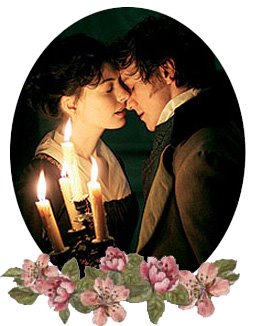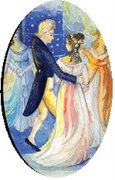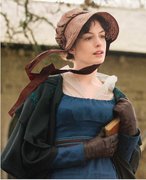Jane Austen Quote of the Week 296
 |
| St. Patrick at the St. Benin Church, Kilbennan, Ireland |
 |
| St. Patrick at the St. Benin Church, Kilbennan, Ireland |
Posted by
Icha
at
08:09
1 comments
![]()
Labels: Quote of the Week
An interesting email came to me last week from Ed Lefroy, a descendant from Thomas Lefroy (see here for our Oct 2007 post). When going through some of the books from Carrigglas Manor (built in 1837 by Thomas Lefroy) he found one called Personal Aspects of Jane Austen by Mary Augusta Austen-Leigh (1838-1922, great niece of Jane Austen) which has a frontispiece of a painting by Zoffany entitled Jane Austen.
The book was published in 1920 and interestingly the painting claiming to be of Jane Austen is the same painting known as the Rice Portrait (see our 2012 post). The Rice Portrait was originally attributed to Johann Zoffany as inscribed in this book but now is believed to have been made by Ozias Humphry (a renowned English painter) around 1788 when Jane Austen was 13 years old. Some still suggest that the painting dates to the early 19th century and thus cannot be of Austen, an interesting mystery.
Do you believe the painting is of Jane? We welcome your comments.
Posted by
Rachel
at
01:08
3
comments
![]()
Labels: About Jane Austen, Austen-inspired books
 |
| That would be what Chief Justice would say. 'Never give up!' |
Believe me, my darling girl, there is no progress to be made in anything without steady and continued application, which, besides the advantages it brings in the way of improvement, makes labour pleasant from habit instead of being irksome, as it always is to the idle and irresolute.
Posted by
Icha
at
22:07
0
comments
![]()
Last night I was fortunate enough to go to see James McAvoy (yes our Becoming Jane Tom Lefroy) in a production on stage of The Ruling Class by Peter Barnes. He was absolutely phenomenal as the paranoid schizophrenic born into a wealthy, aristocratic British family. This play, focussed on social classes has stayed in my mind and today it made me wonder about Jane Austen and how the classes interacted in her time.
Jane Austen wrote often about her world and this included her social class, the gentry. The manners and customs of the gentry are always present in Sense and Sensibility and Pride and Prejudice. I have chosen a quote from chapter 19 of Sense and Sensibility where Edward Ferrars is speaking:
"We never could agree in our choice of profession. I always preferred the church, as I still do. But that was not smart enough for my family. They recommended the army. That was a great deal too smart for me. The law was allowed to be genteel enough; many young men, who had chambers in the Temple, made a very good appearance in the first circles, and drove about town in very knowing gigs. But I had no inclination for the law, even in this less abstruse study of it, which my family approved. As for the navy, it had fashion on its side, but I was too old when the subject was first started to enter it- (…) I was therefore entered at Oxford and have been properly idle ever since"
This fascinates me as in some ways our perceptions, customs and social interactions have changed so much from these times until today but in other ways we are still facing the same issues. For example young people today, in the culture I have familiarity with, typically have autonomy and freedom of choice in terms of their career paths (I do appreciate that this does not apply to all cultures), this suggests that traditions and connections with older times are fading. However at a time where our government in the UK are discussing university tuition fees and affordable housing for average paid workers, it is apparent that the questions and deliberations of class divide that also existed in Jane Austen's time are still very real and at the forefront of many peoples lives.
 Pic: Mr Edward Ferrars
Pic: Mr Edward Ferrars
Posted by
Rachel
at
07:29
2
comments
![]()
Labels: Quote of the Week, Sense and Sensibility




We are rolling a petition to reprint Nadia Radovici’s 1995 book titled ‘A Youthful Love: Jane Austen & Tom Lefroy?’ that is currently out of print. Please sign for the Radovici's Jane Austen & Tom Lefroy Petition and spread the words! Thanks a lot!



Jane Austen was born on

Cast:
Anne Hathaway - Jane Austen
James McAvoy - Tom Lefroy
Julie Walters - Mrs. Austen
James Cromwell - Revd. George Austen (Jane's father)
Maggie Smith - Lady Gresham
Anna Maxwell Martin - Cassandra Austen
Joe Anderson - Henry Austen
Lucy Cohu - Eliza de Feullide
Laurence Fox - Mr. Wisley
Philip Culhane - George Austen (Jane's brother)
Ian Richardson – Judge Langlois
Leo Bill – John Warren
Jessica Ashworth – Lucy Lefroy
Eleanor Methven – Mrs. Lefroy
Michael James Ford – Mr. Lefroy
Sophie Vavasseur – Jane Lefroy
Helen McCrory – Ann Radcliffe
Julian Jarrold - Director
Graham Broadbent, Robert Bernstein, & Douglas Rae - Producer
Adrian Johnston - Soundtrack
Kevin Hood & Sarah Williams - Screenplay writers
Eigil Bryld - Cinematography
Jane Gibson - Choreography
Eimer Ni Mhaoldomhnaigh - Costume
Gail Stevens & Gillian Reynolds - Casting




Jon Spence,


McAvoy knew his portrait of Tom could only come alive with the right Jane, and he found Anne Hathaway almost supernaturally suited for the part. “I don’t think we could have chosen anyone better to play Jane Austen," he says.

Jane Austen’s greatest love story was her own













‘I’m yours, Jane, heart and soul!’
~ Tom Lefroy to Jane Austen, ‘Becoming Jane’

Anything is to be preferred or endured rather than marrying without affection – JA,

Nothing can be compared to the misery of being bound without Love, bound to one, & preferring another – JA,



To be so bent on marriage, to pursue a man merely for the sake of situation – is a sort of thing that shocks me.





The film Becoming Jane has given us an image of Jane Austen that liberates our imagination. I envy readers of my book who come to it with Anne Hathaway’s image of Jane in their mind’s eye. You will not have to struggle against the image Cassandra created to see the Jane Austen who was young and pretty, lively and in love. Anne Hathaway’s skilful portrayal of Jane Austen in Becoming Jane shows that art can have as much power to bring us closer to the truth as facts themselves can.
Jon Spence,